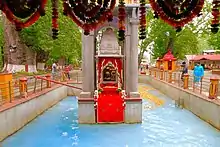Kheer Bhawani
Kheer Bhawani or Ksheer Bhawani is a temple dedicated to the Goddess Kheer Bhavani (Maharagnya Bhagwati) constructed over a sacred spring. The worship of Kheer Bhawani is universal among the Hindus of Kashmir, most of them who worship her as their protective patron deity (Kuladevi). The temple is situated at a distance of 14 miles east of Srinagar near the village of Tulmul. The term kheer refers to rice pudding that is offered in the spring to propitiate the Goddess, which became part of the name of the temple. As is the custom with Hindu deities, she has many names: Maharagya Devi, Ragnya Devi, Rajni, Ragnya Bhagwati, and so on.

| Kheer (Khir or Ksheer) Bhawani | |
|---|---|
 The Goddess in an Atmalinga form at Kheer Bhawani | |
| Religion | |
| Affiliation | Hinduism |
| Deity | Maharagnya Bhagwati |
| Location | |
| Location | Tulmul, Ganderbal |
| Country | India |
| Geographic coordinates | 34°13′16″N 74°43′48″E |
Temple description

It is the most important temple for the Kashmiri Hindus in Kashmir, known as the Kashmiri Pandits, most of them who consider. Around the temple is an area covered with smooth and beautiful stones. In it are large, old-growth chinar trees beneath which the pilgrims sit or sleep on mats of grass. While most of the colours do not have any particular significance, the colour of the spring water changes occasionally. When black or darkish, it is believed to be an indication of inauspicious times for Kashmir. In 1886, Walter Lawrence, the-then British settlement commissioner for land, during his visit to the spring, reported the water of the spring to have a violet tinge.
History
Maharagya was pleased with the devotion of Ravana and appeared before him and Ravana got an image of the Goddess installed in Sri Lanka. However, the Goddess became displeased with the vicious and licentious life of Ravana and so didn't want to stay in Sri Lanka. Therefore, she is believed to have instructed Lord Hanuman to get the image from Sri Lanka and install it at the holy spot of Tulmul. Though Ragniya is a Rupa of Durga, this one is a Vaishnav Rupa in Kashmir. Ragniya is also known as Tripurasundari, while in (Sri) Lanka, the Mother Goddess was called Shayama. Sita too, is believed to have been an incarnation of Ragniya. Ragniya Mahatmya has it that those who meditate on Panch Dashi Mantra during Navreh, Mother Ragniya grants their wish.
It is said that the night during which Mother Goddess came from (Sri) Lanka to Kashmir was named Ragniya Ratri In Kashmir a number of shrines are dedicated to Mother Goddess at Tiker, Bhuvaneshvar, Manzgam (Noor-abad) Bheda, Lo-qraer-pur, Mani-gam, Rai-than and Baed-pur, but the Shrine at Tulmul is the most famous one and hence the focus of yatris. 360 springs (nagas) are said to have gathered there. Ragniya is a Sattavie form of Mother Goddess, i.e. the form of tranquility and bliss.
The mention of Kheer Bhawani is found in Kalhana's Rajtarangini. Kalhana writes that the sacred spring of Tula Mula is situated in a marshy ground. The name of the spring is Mata Ragini Kund (pond).[1]
Maharagini is the form of Durga Bhagvati. The Hindus of Kashmir worship this spring and pilgrims from every corner of the country visit to have the darshan of the place.
In Rajatarangini, Tula Mula and the spring of Maharagnya has been considered very sacred and the Hindus of Tula Mula considered notable for their spiritual prowess. Thousands of years ago, many floods occurred in Kashmir and the sacred spring of Tula Mula was inundated under its sway and the holy place could nowhere be traced. At last, Kashmir's Yogi Krishna Pandit Taploo of Bohri Kadal, Srinagar had a dream in which the Goddess appeared to him and directed that she would swim in the form of a snake at the proper place and that he should stick large poles to demarcate the holy spot in the marsh land. Subsequently, when the water subsided there the holy spot was discovered. This event happened during the Samvat 4041 (Hindu lunar date).Sh. Krishen Joo taploo possessed some valuable manuscripts too like Bhrigu Samhita which was in late Eighties taken away from his family members and now its fate is not known.He even had a huge Shiv Ling which at present is at Bohri Kadal temple. An annual Hawan used to take place coinciding with the discovery of Holy pond of Ksheer Bhawani at his residence before forced migration of Kashmiri Pandits.
Abu'l-Fazl ibn Mubarak in his book Aini-Akbari mentions the area of Tula Mula extending over a region of hundred bighas (unit of land area) of land, which used to sink in the marshy lands during the summer season.
Swami Rama Tirtha and Swami Vivekananda also visited here to have the darshan of the place.[2]
In the past, with incessant offering of milk and sugar candy in the spring by pilgrims, a thick layer of offerings had accumulated at its base. When it was cleared, the ruins of an old temple and shrine slabs engraved with figures were discovered. Here many images were also found but nobody rebuilt the temple till the Samvat 1969 (Hindu lunar date) when Maharaja Pratap Singh who was the disciple of the Goddess, got a temple of marble made in the midst of the spring which shines like a pearl in a shell. The marble temple was completed in 1920s. Some people are of the opinion that there was a mulberry tree near holy spot of Kheer Bhawani which, in local language, is called tul mul. But tul mul is also derived from the Sanskrit word atulya mulya meaning great value. It is believed that Ravana, after his worship of the Goddess, offered her kheer (rice pudding), which she accepted and since then it is called Kheer Bhawani.[3]
Contextual folklore
Pandit Prasad Joo Parimoo, a Kashmiri pandit, is believed to have been a grahasta (house-holder) saint of tall order and as such his peers would call him Jada Bharata, who was a legendary saint of Puranas times. He used to live in Sekidafer area of Srinagar in Kashmir. He was married but didn't have any children so he is said to have finally adopted a son named Madhav Joo. He would regularly meditate at this holy spring and during one such occasion, while being in a meditative trance (samadhi), he is said to have had a vision of the deity of Mata Kheer Bhawani, who reprimanded him for his hasty decision of going for an adoption when she was herself desirous of taking birth in his family as his daughter. Nonetheless, she is said to have blessed him with the boon and eventually Pandit Prasad Joo Parimoo's wife did give birth to a daughter, who was named Haar Maal. Approximate year of her birth would be 1870-1880 (see notes). In the course of time, Smt Haar Maal married Pandit Narayan Joo Bhan and gave birth to a son in 1898 who later came to be called Bhagwan Gopinath during his lifetime.[4]
Swami Vivekananda's Experience
Swami Vivekananda visited Kashmir. During this stay, while ritually worshiping Khir Bhavani, he had the thought: he was astonished by the colour change at that time and cited it as a miracle .
Sacred spring
A unique septagonal spring dedicated to Goddess Kheir Bhawani flows from west(sheer or head section) to the east(padh or feet). The holy spring is known to change its colour with various hues of red, pink, orange, green, blue, white, etc. which was noted by Abul Fazal and Swami Vivekananda. A black shade of the spring water is believed to be inauspicious.[5]
| Part of a series on |
| Hinduism |
|---|
 |
|
Gallery
 Kheer Bhawani temple
Kheer Bhawani temple Kheer Bhawani temple-A closer look
Kheer Bhawani temple-A closer look Kheer Bhawani temple
Kheer Bhawani temple Flowers in the holy spring
Flowers in the holy spring Kheer Bhawani temple-At Night
Kheer Bhawani temple-At Night
References
Three Shrines of Khir Bhawani - Tul-Mul, Mani Gam and Raithan from Kosher Encyclopaedia-Vol. 1 & 2 Cultural Academy
Original piece written by Pt. Moti Lal Saqi Translatied by Dr. R.L. Bhat
- "Full text of "Rajatarangini of Kalhana - English - Jogesh Chunder Dutt Volumes 1 & 2"". archive.org. Retrieved 20 July 2015.
- "Swami Vivekananda in Kashmir - Scoop News Jammu Kashmir". www.scoopnews.in. Retrieved 20 July 2015.
- "Kashmir: Tul Mul". ikashmir.net. Retrieved 20 July 2015.
- Dhar, T N. (2004), Saints and Sages of Kashmir, New Delhi: APH Publishing Corporation, p. 310,Chapter-28, ISBN 81-7648-576-4
- http://www.koausa.org/Crown/marvels.html
Notes
The timelines (i.e. 1870–1880) regarding Mata Kheer Bhawani's birth needs further research for the sake of accuracy. Currently it has been extrapolated approximately using the birth year of Bhagwan Gopinath.
